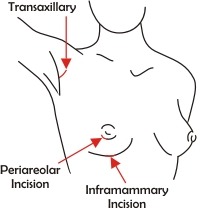Preparing for Your Surgery
Our board-certified plastic surgeon, Dr. Neil J. Zemmel, will give you instructions to prepare for your breast augmentation surgery. He will go over this with you during your pre-operative consultation and give you a written instruction packet. These instructions are also downloadable on our patient forms page. Instructions regarding eating and drinking, smoking, and taking or avoiding certain vitamins and medications will be given. You will be instructed on when you can bathe, drive, and return to normal activity. You will also need to arrange transportation to and from the hospital for surgery and for the next several days.
- Anesthesia
- The Actual Surgery
- Recovery After Surgery
- Risks of Breast Augmentation Surgery
- Returning Back to Normal
- Your Body
Anesthesia
Dr. Zemmel performs breast augmentation with a deep sedation or general anesthesia. You will sleep through the entire operation. You will be unaware of the entire surgery, and be pain free while surgery is taking place. Your surgeon and the anesthesia provider will give you medication before, during, and after surgery for nausea. He will take every precaution to prevent post operative nausea and vomiting and to make you as comfortable as possible.
The Actual Surgery
 The incisional approach for inserting your implant will depend on your breast shape and your surgeon’s recommendation. The incision can be made either in the crease under the breast (Inframammary), around the areola (the periaerolar approach), or in the armpit (transaxillary). Our surgeon will make every effort to place the incision so that the final scar will be as hidden as possible.
The incisional approach for inserting your implant will depend on your breast shape and your surgeon’s recommendation. The incision can be made either in the crease under the breast (Inframammary), around the areola (the periaerolar approach), or in the armpit (transaxillary). Our surgeon will make every effort to place the incision so that the final scar will be as hidden as possible.
Your surgeon will lift your skin, breast tissue, and pectoralis muscle and to create a pocket for the implant to rest in. The entire operation is designed to create a finely tailored pocket for the implant to rest in. The implants are then centered directly beneath your nipple and areola to give the optimum shape and projection.
Dr. Zemmel completes a primary breast augmentation surgery in approximately one hour. Absorbable stitches are used to close the incisions so the are no sutures to remove. You will wake up from surgery with a light dressing in place and a soft sports bra for additional support. Dr. Zemmel typically sees his breast augmentation patients one to two days after surgery for follow up. You will leave the dressings in place until your first follow up visit.
Our surgeon provides patients with very close postoperative follow up and remains in constant communication with his patients. You will be given his private cell phone number in the event that any issues arise.
Recovery After Surgery
The initial recovery period for breast augmentation last 5 to 7 days. You will feel tightness and soreness across the chest as your breast accommodate the new volume from the implant. The soreness feels similar to having performed many pushups or chest exercises at the gym. Most patients report the postoperative discomfort to be muscle soreness and tightness. You will be prescribed a narcotic pain medication (Percocet or Dilaudid) and a muscle relaxant (valium) to help with the initial pain. Most patients use the medication for 5 to 7 days postoperatively. Since the discomfort is mostly due to muscle spasm many patients report that the Valium treats the majority of the pain.
You will feel tired for 24 to 48 hours after surgery, but you will be up and around quickly. You will be allowed to shower 48 hours after surgery, and will also be able to perform your normal activities of daily living at that time. You will not be allowed to perform any heavy lifting or upper extremity work for 10 to 14 days after surgery. This is to ensure that the implants heal in proper position and do not move.
Risks Of Breast Augmentation Surgery
Breast implant surgery is one of the most common cosmetic procedures performed in the United States. However with any surgery, there are intrinsic risks associated with this procedure.
As with any operation, excessive bleeding may rarely occur. This may cause enlargement of the breast with severe swelling and pain. In rare cases it may be necessary to return to the operating room to remove the blood from around the implant.
A very small percentage of patients can develop an infection around the implant. This most often occurs 7 to 10 days after surgery. In some cases the infection can be treated locally with antibiotic medication. Other more severe cases may require removal of the implant. After several months the implants can usually be reinserted.
A small percentage of women can develop a capsular contracture. All human implants whether it is an artificial hip, screw, or breast implant develop a thin layer of tissue between the device and the body. This is your body’s way of separating the implant from your self. In most cases the layer of tissue is very thin and pliable. This is completely normal and patients do not even feel its presence.
In a very small number of patient the capsule around the implant can become thick and hard and tighten around the implant. This contraction of the soft implant can cause the breast to feel hard. Capsular contracture can be treated with a number of modalities. Occasionally it requires either removal of the scar tissue, or perhaps removal or replacement of the implant.
Occasionally, breast implants may develop a crack in the outer shell and rupture. All medical devices have a lifetime and you should expect to change you implants once or twice during your life. In the event of a saline implant rupture, the breast typically deflates over several days time. Your body will absorb the harmless saline solution. You will contact your surgeon immediately and schedule an implant exchange procedure. This replacement surgery is much easier than the initial surgery as the breast pocket is already developed. All that is necessary is to reopen the prior incision and remove and replace the deflated implant under sedation in the operating room. Recovery time for this procedure is one or two days. For silicone breast implant patients, rupture is detected with an MRI. In the event of a silicone rupture, the replacement procedure is similar to that of saline implants. In the even of a rupture, Mentor and Allergan breast implant warranties will give you a new pair of implants at no charge and fund the cost of the anesthesia and operating room.
Some women report changes in sensation of the nipples after surgery. The nipples can become under sensitive, oversensitive, or even completely numb. In cases of hypersensitivity or partially number after surgery, these symptoms usually resolve in several weeks. Permanent, complete numbness of the nipple is an extremely rare event.
There is no evidence that breast implants increase the risk of breast cancer. However, mammography must be done with special views (Eklund views) in order to completely view the breast tissue. Most mammographers know this technique well as millions of women in the United States have undergone breast implant surgery. An ultrasound may be also be necessary to fully view and breast lump of mass detected or the fully view the implant.
The majority of women experience no complications during breast implant surgery. our surgeon will discuss each of the above issues in great detail during your consultation. Please write down any questions you may have and our surgeon will be happy to go over them with you.
Returning Back To Normal
Dr. Zemmel recommends taking several days off from work during your initial recovery. Depending on the level of physical activity required for your job, you may need more time off. In general our surgeon recommends only light activity for the first 7 to 10 days. You will not be able to lift heavy objects. You will not be able to raise you arms above shoulder level during this time and you should plan on having light help around the house.
You will be allowed to return to exercise approximately 2 weeks after surgery. You will first be allowed light cardio activity, followed by full cardio one week later. You will allowed to return to full activity in the gym at around one month after surgery.
Your scars will be slightly dense and red for 6 to 12 weeks after surgery. Over time they will soften and the redness will fade as your body heals. You will always have a small faint line where the incision was made. Dr. Zemmel takes great care in ensure the final scar will be as hidden and inconspicuous as possible.
Once you are completely healed, the implants will become a normal part of your body. You will slowly become unaware of the implant. There will be no permanent physical restrictions.
Your Body
 The overwhelming majority of women are satisfied with their breast augmentation. Breast augmentation has one of the highest satisfaction rates amongst all plastic surgery procedures. For most patients, the results provide an immediate increase in self-esteem and a positive change in body image.
The overwhelming majority of women are satisfied with their breast augmentation. Breast augmentation has one of the highest satisfaction rates amongst all plastic surgery procedures. For most patients, the results provide an immediate increase in self-esteem and a positive change in body image.
You will undergo periodic examination by your surgeon to make sure your implant and final results are stable and satisfactory. In age appropriate groups, patients will undergo routine mammograms.
The decision to undergo breast augmentation is an intensely personal, private decision. Your friends and family members may not understand or agree with your decision, but the final decision is yours. Breast augmentation should be performed for you and you alone. Dr. Zemmel’s ultimate goal is to make you happy and if this goal is met then your surgery is successful.





